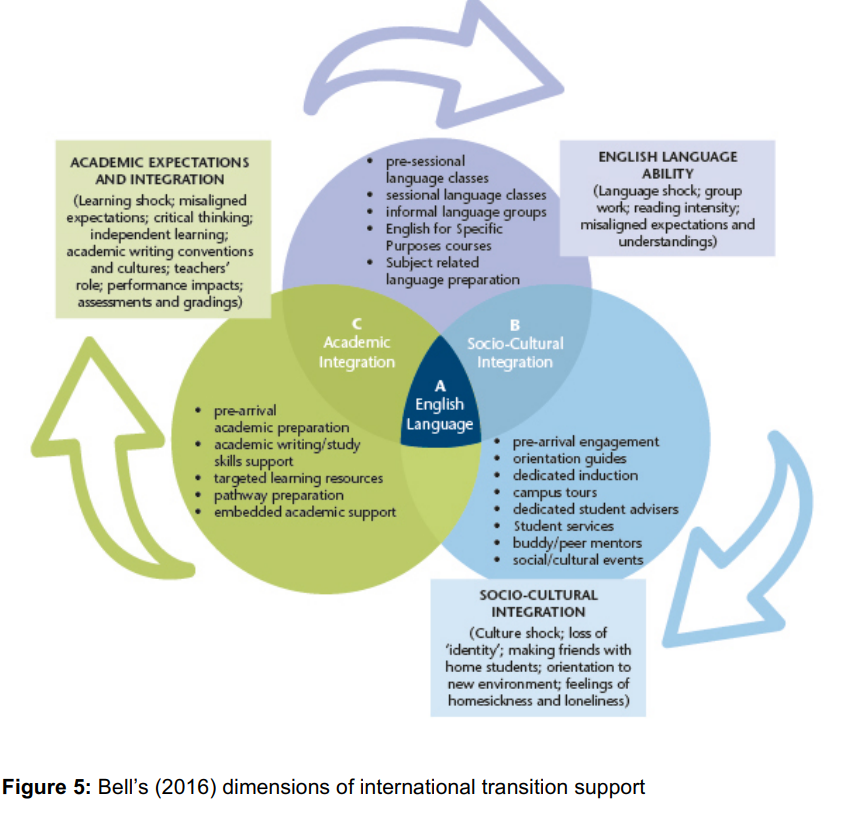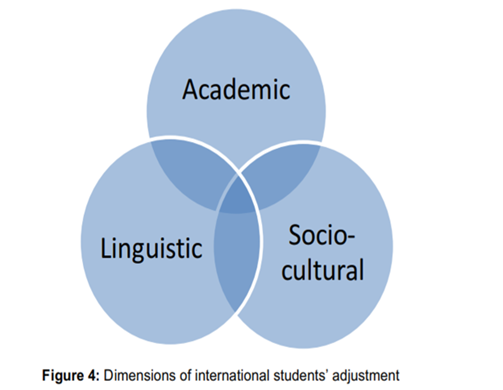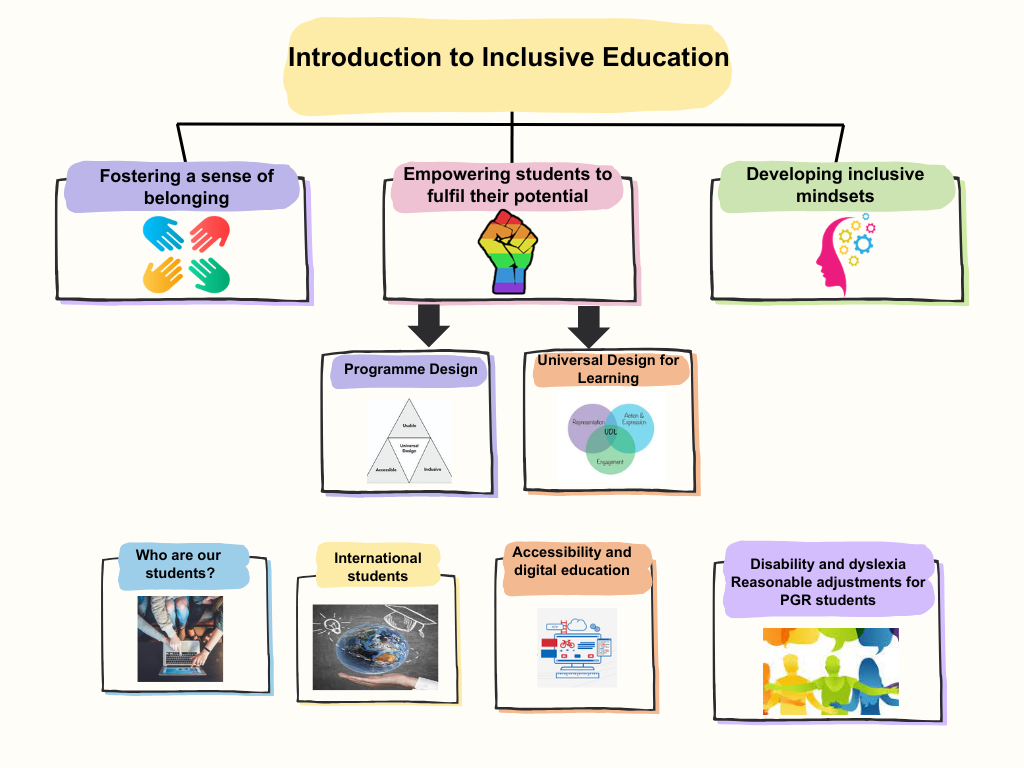Transition and Induction
Transition and Induction
Universities offer a wide range of induction processes for students with a focus on transitioning them successfully into the new educational culture. However, when discussing transition, we do not just mean the first few weeks of university but how students navigate the student journey and transitions in, through, and out of university.
The process of transition in the broadest sense is complex and includes a huge range of stakeholders and intersectional identities. Students find the transition process challenging (Kift et al, 2010), and research suggests that for international students the process is even harder to navigate (Wu & Hammond 2011). Induction plays an important role in the success of students climatising to their new context and minimising the effects of culture shock. It can also help students form a network that becomes the basis for teamwork within the academic setting and peer support for the wider student experience.
Below you will find advice based on Bell’s (2016) dimensions of the international transition support model.

Transitions can happen throughout the student journey and when successful can lead to the development of identities and new ways of knowing (Beach 1999, in Ecohard and Fotheringham 2017:101). Ploner (2018) discusses academic hospitality which focuses on the reciprocal exchange between ‘host’ and ‘guest’. When you apply this concept to international students you are reframing the deficit narrative and moving towards the notion of actively valuing and learning from different cultures.
Students entering university will have mixed experiences and expectations. International students traveling to study have already demonstrated a commitment to studying in another country. However, the reality can be very different from the expectation. For a home student, the process of entering a new context can be challenging in many ways. The additional dimensions of acculturation and adjustment within the process of transition create an extra challenge for international students. These need to be considered when planning induction and transition processes. Bridging the gap between prior experience and expectations to ensure that all students can perform to their potential does not mean changing what we ask of students, but it does mean recognising the scale of the transition for some students (Scudamore 2013).
Scudamore (2013: 10) identifies several phases to transition that can last over a few months, some or all might be experiences by students:

Figure: Stages of transition (Scudamore 2013 p10)
Dimensions of adjustment
Broadly the literature presents 3 dimensions of adjustment for international students

Here is an example of some challenges international students may face when adjusting to university:
| Academic | Linguistic | Sociocultural |
| Teaching practices | Communicating with native speakers (speed, accent, register, body language and colloquialism etc) | Navigate new city, work out public transport, find accommodation |
| Classroom dynamics | A mismatch between standardised proficiency tests and reality | Make new circle of friends |
| Core traditions of L&T (e.g. student centred learning) | Understanding and producing academic texts | Join healthcare system |
| Core values (e.g. concepts of success) | Adapt to food, weather, social conventions | |
| Assignments and assessment methods | Deal with financial pressures |
References
References
Ecochard, S. and Fotheringham, J. (2017). International students’ unique challenges – Why understanding international transitions to Higher Education matters. Journal of Perspectives in Applied Academic Practice, 5:2, 100-108
Héliot, Y., Mittelmeier, J. and Rienties, B. (2020). Developing learning relationships in intercultural and multi-disciplinary environments: a mixed method investigation of management students’ experiences. Studies in Higher Education, 45: 11
Lomer, S. and Mittelmeier, J. (2023). Mapping the research on pedagogies with international students in the UK: a systematic literature review. Teaching in Higher Education, 28:6, 1243-1263,
Lomer, S., Mittelmeier, J. and Carmichael-Murphy, P. (2021). Cash cows or pedagogic partners? Mapping pedagogic practices for and with international students. Society for Research into Higher Education (Research Report). University of Manchester.
Lomer, S. (2017). Recruiting International Students in Higher Education Representations and Rationales in British Policy. Basingstoke: Palgrave Macmillan
Marlina, R. (2009). ‘I Don’t Talk or I Decide Not to Talk? Is It My Culture?’- International students’ experiences of tutorial participation. International Journal of Educational Research 48:4, 235–44.
Newsome, L. and Cooper, P. (2016). International students’ cultural and social experiences in a British university: “Such a hard life [it] is here”. Journal of International Students, 6:1, 195-215
Rhoden, M. (2019). Internationalisation and intercultural engagement in UK Higher Education – Revisiting a contested terrain. In International Research and Researchers Network Event. Society for Research in Higher Education.
Scudamore, R. (2013) Engaging home and international students: A guide for new lecturers. The Higher Education Academy.
Straker, J. (2016) International student participation in Higher Education: Changing the focus from “International Students” to “Participation”. Journal of Studies in International Education, 20(4), 299-318.
Where Next?
Map of Topics
Below is a map of the toolkit and workshop topics, to aid your navigation. These will be developed and added to in future iterations of this toolkit:

You’re on page 9 of 9 Inclusivity theme pages. Explore the others here:
1.Inclusivity and the CU Inclusive Education Framework
2.Introduction to Inclusive Education
3.Fostering a sense of belonging for all students
4.Empowering students to fulfil their potential
5.Developing inclusive mindsets
6.Universal Design for Learning